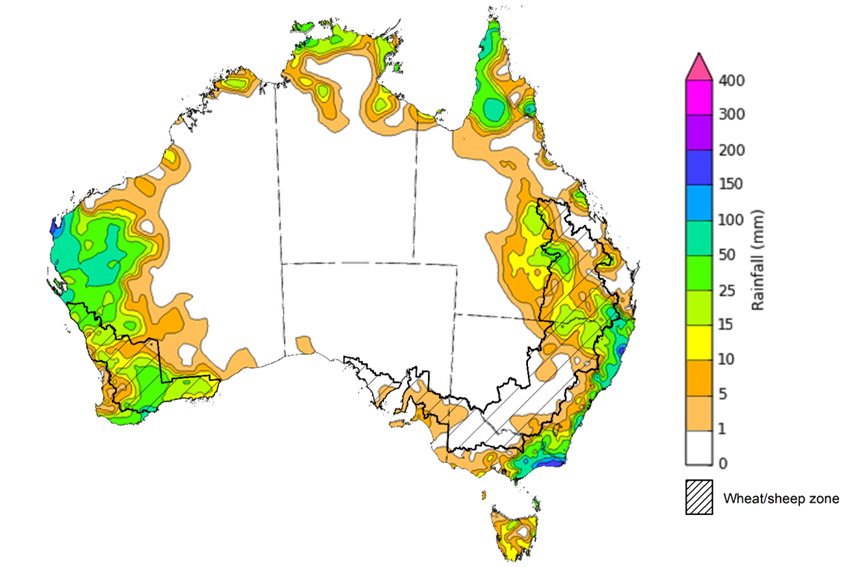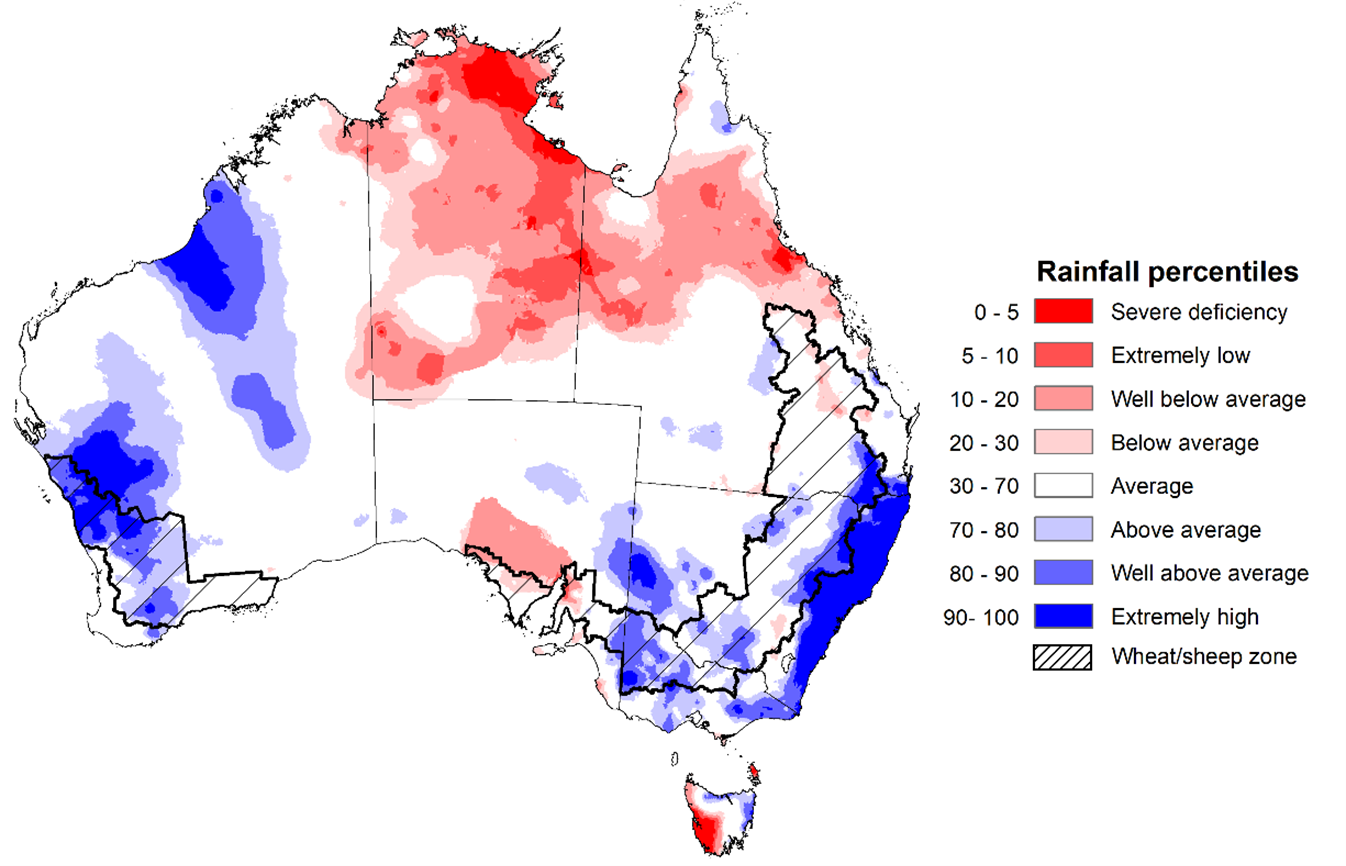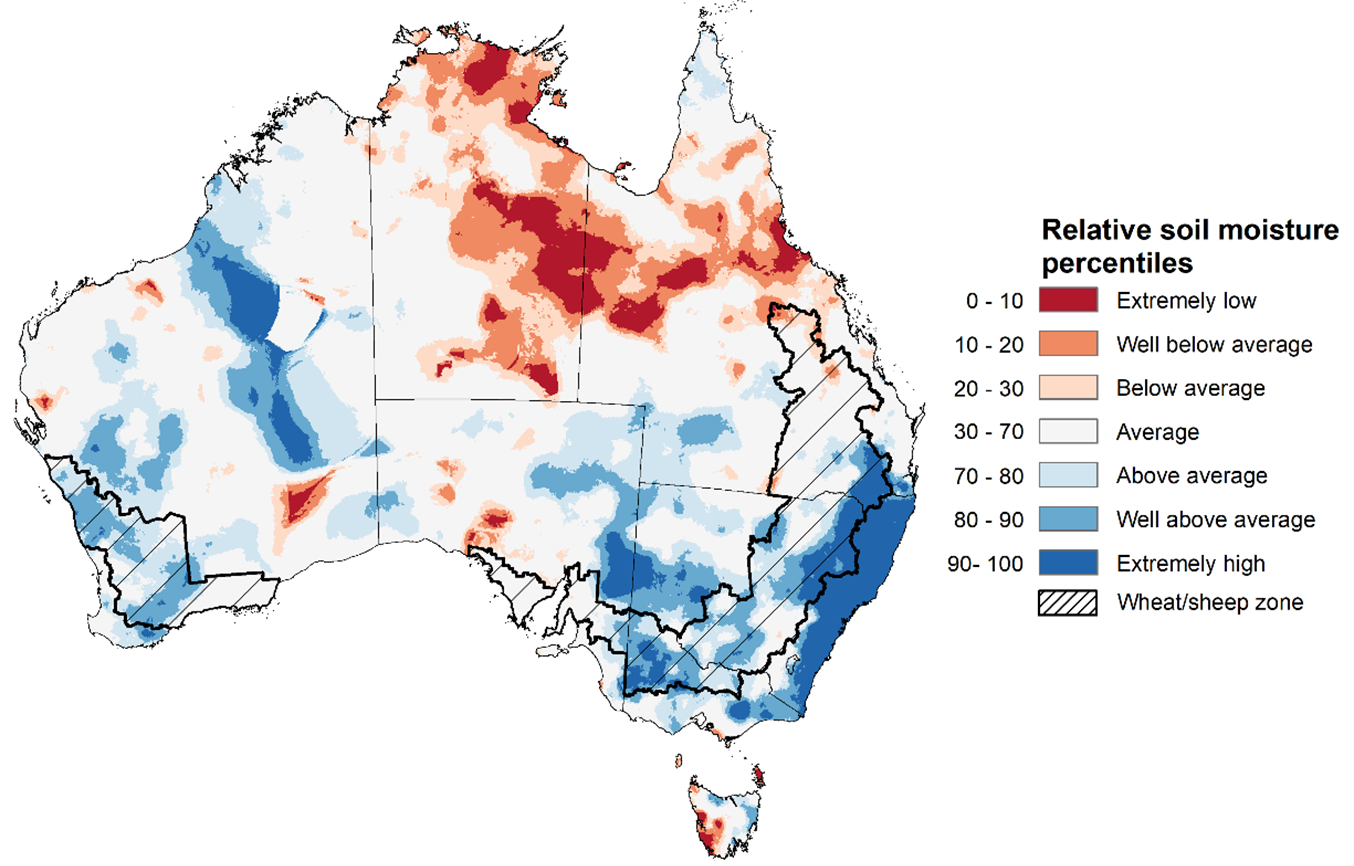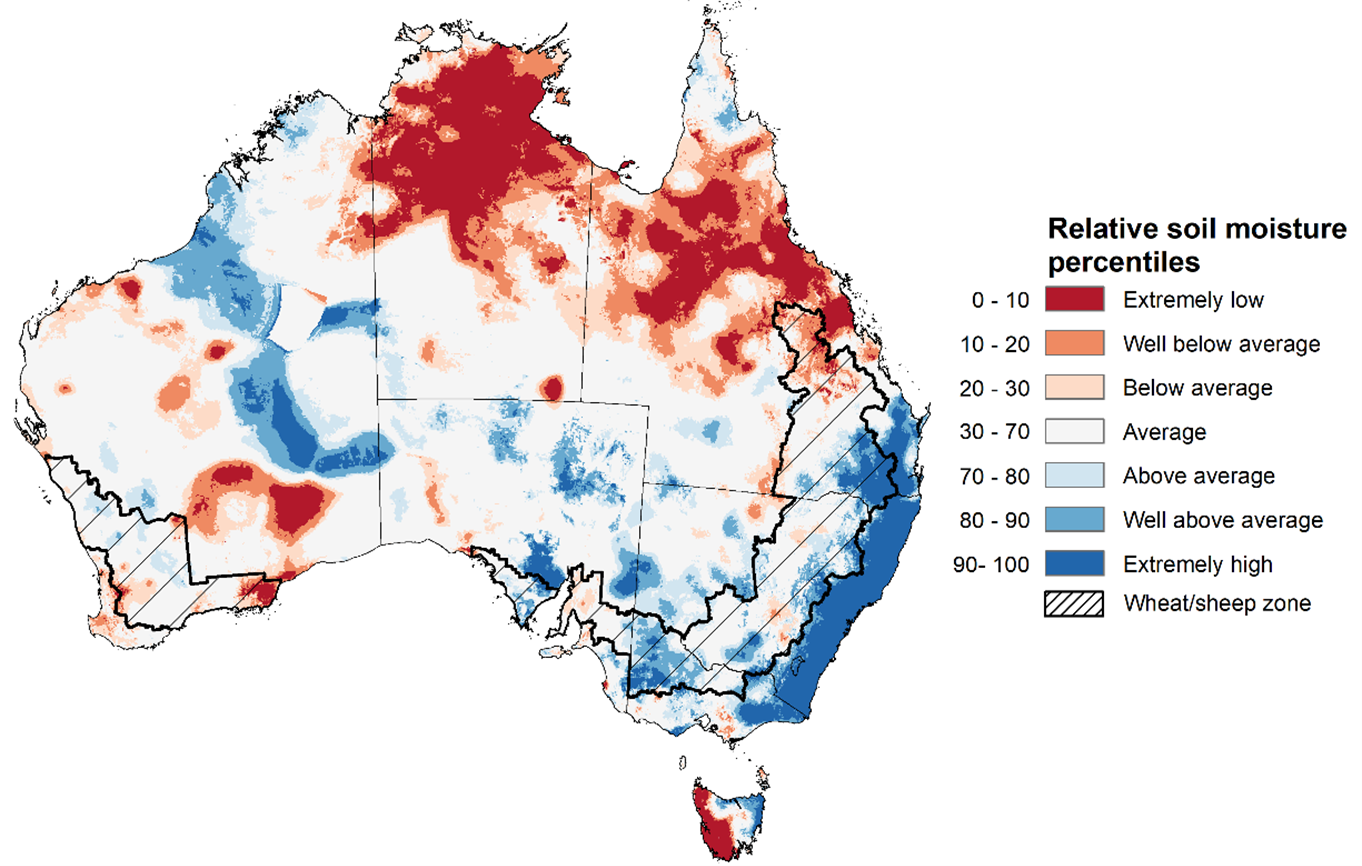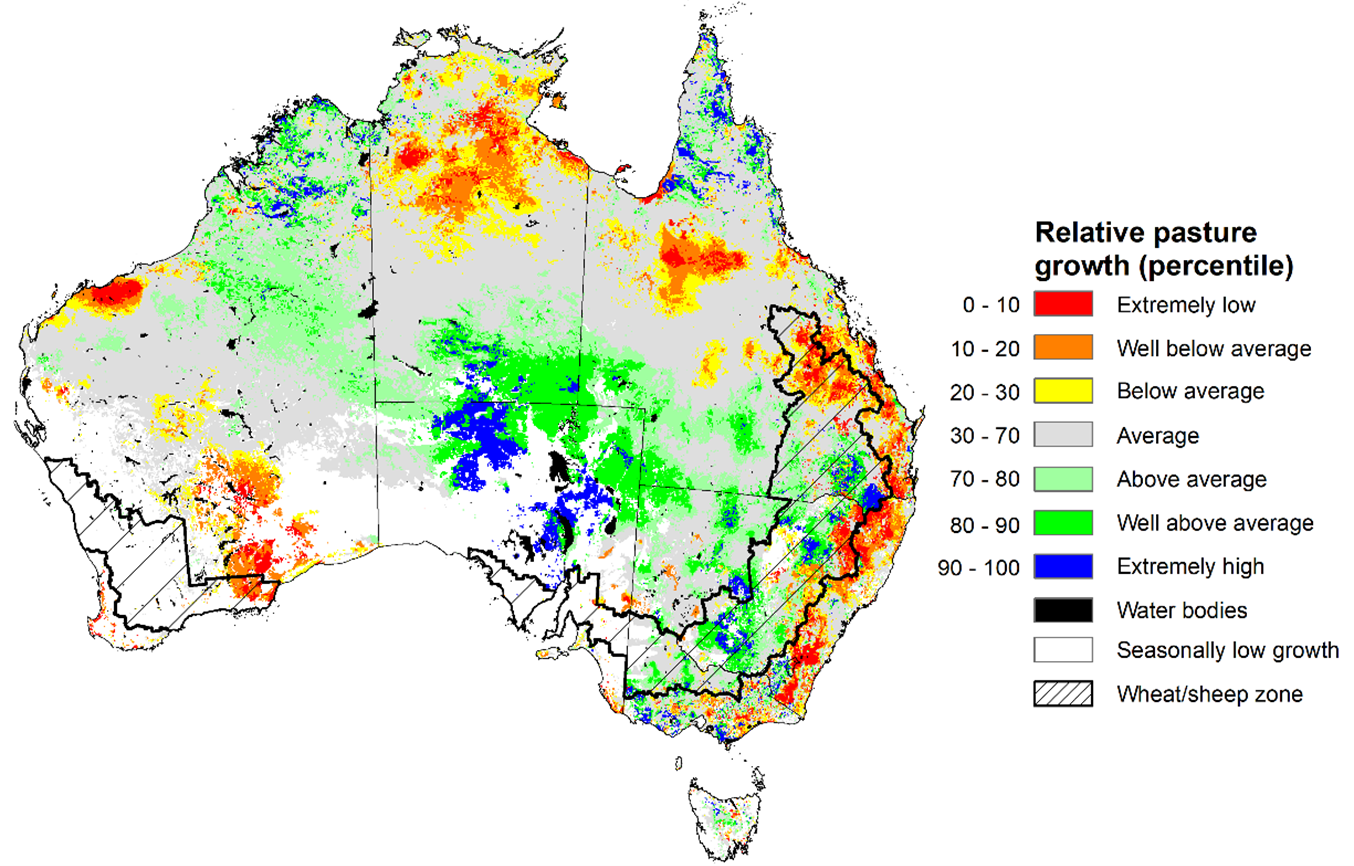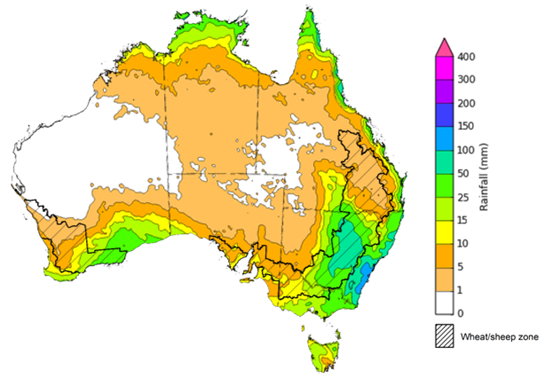- For the week ending 6 March 2022, low-pressure troughs across northern, eastern and western Australia resulted in moderate rainfall in the east, west and parts of the far north. High-pressure systems in the south resulted in clear, dry conditions for large areas of central and southern Australia.
- Rainfall in parts of northern New South Wales and southern Queensland will have exacerbated wet conditions, further delaying field access and increasing the chance of quality downgrades. The wet conditions in recent weeks mean that some early sown summer crops are still awaiting harvest. Cotton harvesting is underway in northern cropping regions of Queensland, but the wet conditions are expected to delay the start in southern Queensland and New South Wales. Across Australian cropping regions, preparation for winter sowing is underway where field access allows.
- Rainfall during March 2022 was 27% below average for Australia as a whole. Rainfall was severely deficient to below average in central and western Queensland, parts of south-central South Australia, most of the Northern Territory and western Tasmania. However, above average to extremely high rainfall was recorded across eastern and southern New South Wales, the far south-east of Queensland, western parts of Western Australia, including the Kimberley, and across large parts of Victoria, and north-eastern Tasmania.
- For the 3 months to March 2022, above average rainfall totals and mild summer temperatures resulted in average to well above average pasture production for this time of year across most grazing regions in New South Wales, Queensland, western and northern Victoria, northern South Australia, northern Western Australia, and the south of the Northern Territory. Extremely low to below average pasture growth rates were recorded across southern Western Australia, south-eastern Victoria, parts of central and northern Queensland and the north of the Northern Territory.
- Over the 8-days to 14 April 2022, troughs and low-pressure systems drawing down moisture laden air are expected to bring rainfall to much of south-eastern Australia, with cold fronts expected to bring rainfall to parts of western and southern Australia. Meanwhile, high pressure systems are expected to bring mostly dry conditions to central Australia.
- Water storage in the Murray–Darling Basin (MDB) decreased by 96 gigalitres (GL) between 30 March 2022 and 7 April 2022. The current volume of water held in storage is 21,567GL, which represents 85 per cent of total capacity. This is 49% or 7,124 GL more than at the same time last year.
- Allocation prices in the Victorian Murray below the Barmah Choke increased from $60 per ML on 30 March 2022 to $70 per ML on 6 April 2022. Prices are lower in the Goulburn-Broken, Murrumbidgee and regions above the Barmah choke due to the binding of the Goulburn intervalley trade limit, Murrumbidgee export limit and Barmah choke trade constraint.
Climate
For the week ending 6 March 2022, low-pressure troughs across northern, eastern and western Australia resulted in moderate rainfall in the east, west and parts of the far north. High-pressure systems in the south resulted in clear, dry conditions for large areas of central and southern Australia.
Rainfall totals of between 10 and 50 millimetres were recorded across parts of eastern and north-eastern parts of New South Wales, south-eastern, central and far northern Queensland, eastern Victoria, western and southern parts of Western Australia, as well as northern parts of the Northern Territory and parts of Tasmania. Rainfall totals in excess of 50 millimetres were recorded across coastal areas of New South Wales, south-east and northern Queensland, far-eastern Victoria and the west of Western Australia. Remaining parts of Australia received little to no rainfall.
In cropping regions, rainfall totals of between 10 and 50 millimetres were recorded across isolated areas of northern New South Wales, southern and western Queensland and most of Western Australia. Rainfall in excess of 100 millimetres was recorded in isolated parts of cropping regions in south-eastern Queensland. Little to no rainfall was recorded across cropping regions in remaining parts of New South Wales and Queensland, as well as Victoria and South Australia.
Rainfall in parts of northern New South Wales and southern Queensland will have exacerbated wet conditions, further delaying field access and increasing the chance of quality downgrades. The wet conditions in recent weeks mean that some early sown summer crops are still awaiting harvest. Cotton harvesting is underway in northern cropping regions of Queensland, but the wet conditions are expected to delay the start in southern Queensland and New South Wales. Across Australian cropping regions, preparation for winter sowing is underway where field access allows. Growers in central and southern New South Wales are reported to have dry sown winter crops ahead of an expected autumn break over the next 8 days.
Rainfall for the week ending 7 April 2022
Note: The rainfall analyses and associated maps utilise data contained in the Bureau of Meteorology climate database, the Australian Data Archive for Meteorology (ADAM). The analyses are initially produced automatically from real-time data with limited quality control. They are intended to provide a general overview of rainfall across Australia as quickly as possible after the observations are received. For further information go to http://www.bom.gov.au/climate/rainfall/
Rainfall during March 2022 was 27% below average for Australia as a whole. Rainfall was severely deficient to below average in central and western Queensland, parts of south-central South Australia, most of the Northern Territory and western Tasmania. However, above average to extremely high rainfall was recorded across eastern and southern New South Wales, the far south-east of Queensland, western parts of Western Australia, including the Kimberley, and across large parts of Victoria, and north-eastern Tasmania.
The main climate influences for March were a La Niña event in the Pacific, a positive South Annular Mode resulting in persistent high-pressure systems over the Great Australian Bight, and above average sea surface temperatures to the north-west and south-east of Australia. East Coast Lows brought extremely high rainfall totals across the east coast in the early and latter parts of March.
March rainfall was average to above average across cropping regions of New South Wales, Victoria and Western Australia, as well as most of Queensland, with below average falls recorded in cropping regions of Central Queensland and parts of South Australia.
The extremely high rainfall across eastern New South Wales and south-eastern Queensland resulted in localised flooding as well as crop losses. Moreover, the wet weather has further delayed the harvesting of mature summer crops. Across southern and western cropping regions, the wet weather has topped up soil moisture levels as winter sowing activity gets underway in some regions.
Rainfall percentiles for March 2022
Upper layer soil moisture in March 2022 was extremely low for this time of year across much of northern Queensland, isolated parts of South Australia and Western Australia, as well as large parts of the Northern Territory and western Tasmania due to below average rainfall in these areas during March. Extremely high upper layer soil moisture was evident across large areas of New South Wales, south-east Queensland, Victoria, the east of South Australia, as well as the west and central areas of Western Australia reflecting heavy rainfall events towards the beginning of March. Modelled upper layer soil moisture was generally average across the remainder of the country.
At this time of year, upper layer soil moisture is important for the establishment and vegetative growth of late planted summer crops in the Central Queensland growing region and for pasture growth across northern Australia. It is also important indicator of the ability to access paddocks to undertake harvest and planting activities for long season winter crops.
Upper layer soil moisture was average to above average for this time of year across most cropping regions in New South Wales, Victoria and Western Australia, as well as southern Queensland. Upper layer soil moisture was below average to average for isolated parts of the northern Queensland growing region. Extremely high to above average upper layer soil moisture was evident across much of north-eastern New South Wales and west Victorian cropping regions. Extremely high upper layer soil moisture would have prevented field access for growers across much of New South Wales and south-east Queensland. The below average to average upper layer soil moisture in parts of northern Queensland may have negatively impacted late sown summer crops, but likely allowed field access for cotton harvesting to commence and field preparation for winter sowing.
Modelled upper layer soil moisture for March 2022
Lower layer soil moisture for March 2022 was well above average to extremely high for this time of year across parts of south-eastern, south-central and north-western Australia. Lower layer soil moisture was well below average to below average across the much of central and northern Queensland, isolated parts of Western Australia, the north of the Northern Territory and western Tasmania.
In cropping regions, lower layer soil moisture was well above average to extremely high for parts of eastern New South Wales, south-east Queensland, Western Victoria as well as parts of the Eyre Peninsula in South Australia. Lower layer soil moisture was extremely low to below average for central and northern Queensland and eastern parts of Western Australian cropping regions. The below average lower layer soil moisture may reduce yield potentials for late sown summer crops in Central Queensland as their root systems extend into lower soil layers. Similarly, pasture growth in northern parts of Queensland and the Northern Territory has likely struggled due to the lack of lower layer moisture.
Modelled lower layer soil moisture for March 2022
January to March is the peak pasture growth period across much of northern Australia which typically provides the bulk of feed to maintain production through the low pasture growth months of the northern dry season. Across southern Australia, January to March pasture growth is typically low reflecting lower rainfall totals, high temperatures and high evapotranspiration rates at this time of year. Pasture availability during this period influences the growth and branding and marking rates of lambs and calves, livestock turnoff and the production of meat, milk, and wool.
For the 3 months to March 2022, above average rainfall totals and mild summer temperatures resulted in average to well above average pasture production for this time of year across most grazing regions in New South Wales, Queensland, western and northern Victoria, northern South Australia, northern Western Australia, and the south of the Northern Territory. Extremely low to below average pasture growth rates were recorded across southern Western Australia, south-eastern Victoria, parts of central and northern Queensland and the north of the Northern Territory consistent with above average temperatures and/or below average rainfall. In contrast, below average pasture growth rates across parts of eastern New South Wales and south-eastern Queensland are likely the result of below average temperatures and waterlogged soils.
Average to extremely high pasture production across much of New South Wales, southern Queensland, South Australia, northern Western Australia and the south of the Northern Territory will likely enable farmers to continue to rebuild stock numbers and provide opportunities to build standing dry matter availability. Below average temperatures and waterlogged soils across of eastern New South Wales and south-eastern Queensland may have restricted summer pasture growth, however, it comes after extremely high pasture growth during winter and spring that supplied average to above average pasture availability and ample opportunities to conserve excess fodder.
Relative pasture growth for 3-months ending March 2022 (1 January to 31 March 2022)
Source: Queensland Department of Science, Information Technology and Innovation
Over the 8-days to 14 April 2022, troughs and low-pressure systems drawing down moisture laden air are expected to bring rainfall to much of south-eastern Australia, with cold fronts expected to bring rainfall to parts of western and southern Australia. Meanwhile, high pressure systems are expected to bring mostly dry conditions to central Australia.
Rainfall totals of between 10 and 100 millimetres are forecast for eastern and central New South Wales and Victoria, as well as parts of south-central and eastern Queensland, southern parts of Western Australia, the far north of the Northern Territory and much of Tasmania. Rainfall in excess of 100 millimetres is expected for south-eastern New South Wales.
In Australian cropping regions, rainfall totals of between 10 and 100 millimetres are expected across much of New South Wales, with totals of between 10 and 50 millimetres expected in southern and eastern Victoria, past of south-western Queensland, as well as southern Western Australia. Little to no rainfall is forecast for all remaining cropping regions during the next 8-days.
The dry conditions across most cropping regions in Queensland will be a welcome break from heavy rainfalls in the past month. Soil moisture levels are well above average for parts of southern Queensland and much of northern New South Wales, delaying the harvesting of summer crops and planting of long season winter crops. The forecast dry conditions across most Queensland cropping regions will allow soil profiles to drain and mature crops to dry out. There are reports of yield losses for early sown sorghum crops due to grain shattering, as well as a high risk of production losses and ginning delays for cotton crops in southern Queensland and northern New South Wales due to recent rainfall. If realised, the rainfall across central and southern New South Wales would constitute an ideal autumn break, with planting of winter crops likely to get underway in the coming weeks, and plentiful plant available water to support germination and establishment.
Total forecast rainfall (mm) for the period 7 March to 14 April 2022
Note: This rainfall forecast is produced from computer models. As the model outputs are not altered by weather forecasters, it is important to check local forecasts and warnings issued by the Bureau of Meteorology.
Water
Water storages, water markets and water allocations - current week
The Tableau dashboard may not meet accessibility requirements. For information about the contents of these dashboards contact ABARES.
Commodities
Information on weekly price changes in agricultural commodities is now available at the Weekly commodity price update.

